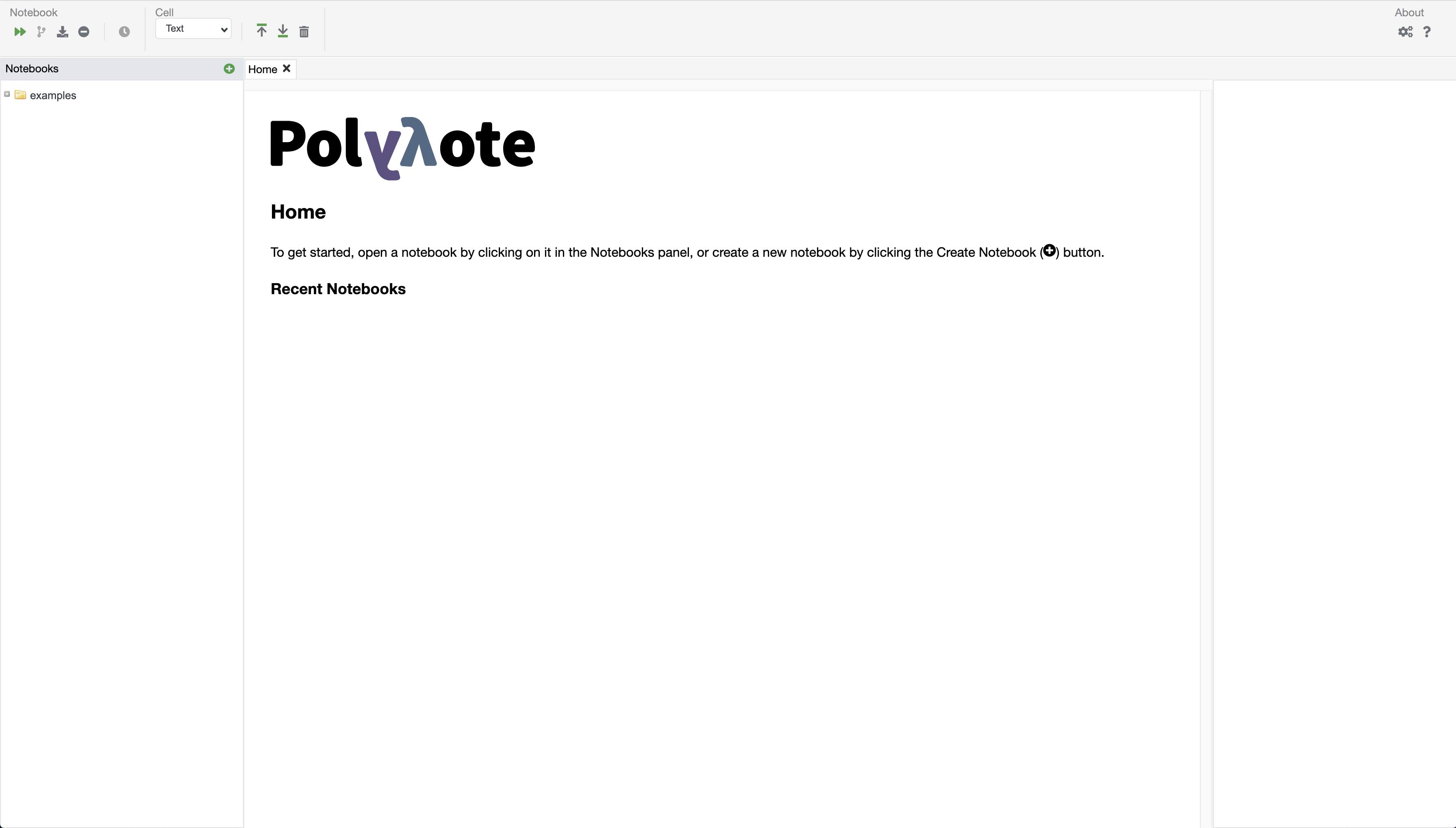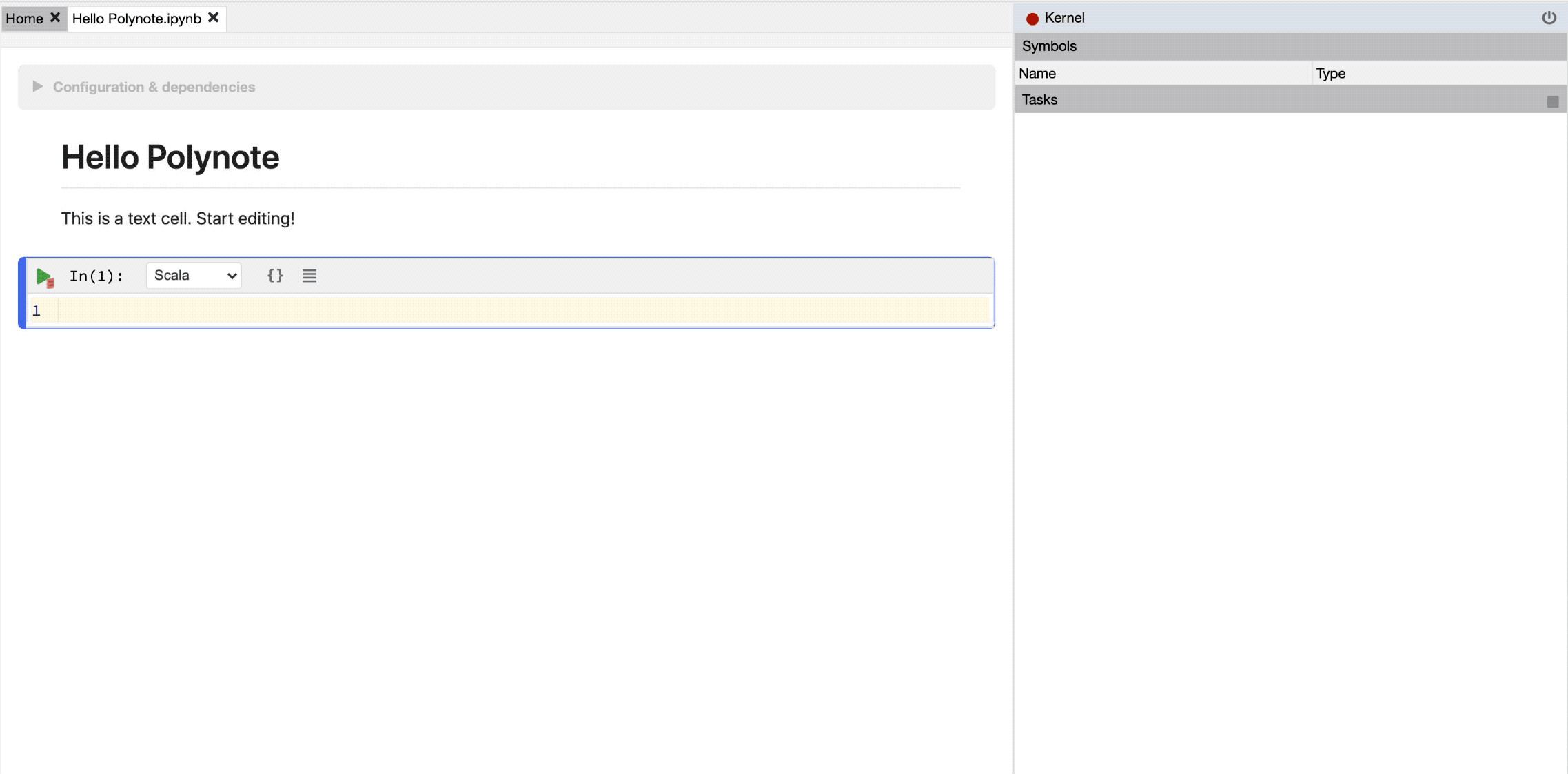Basic usage¶
Info
This page aims to get you up and running with your first Polynote notebook. For a more in-depth walk through the Polynote user interface, check out the Tour.
After starting Polynote and opening the application in your browser at http://localhost:8192/ you'll see the home page.

On the left is the list of notebook files. If you have just installed Polynote, the only notebooks you will have access to are our examples. Feel free to browse these notebooks for your future reference.
Creating a new notebook¶
For now, though, we'll just jump right into creating a new notebook.


Click the "New notebook" button (left), and a dialog will come up (right). Enter a name for your notebook and then click "Create".

The new notebook appears in the Notebooks List ①, and is opened in a Polynote tab ② with the Configuration Pane open ③.
We'll ignore the configuration for now, so click anywhere on the ▼ Configuration & dependencies heading
④ to close it.
You'll see that the notebook contains a single text cell. Click on that cell and you'll see the text editing toolbar appear (shown boxed in the image below).

This contextual toolbar appears when it's useful, based on the currently active cell. You'll see it change as you interact with cells of various types.
Check out the tour for a more comprehensive breakdown of the toolbar and the different cell types.
Creating a new cell¶
A notebook document is made up of a collection of cells. Currently, Polynote supports three cell types: text cells, code cells, and visualization (viz) cells.
Text cells are useful for writing rich text explanations, code cells contain the code that actually gets run in the notebook, and viz cells aid in inspecting and visualizing data.
Now that we've seen a text cell, let's create a new code cell. If you hover the mouse above and below the text cell,
you'll see a divider appear with a small + symbol. Clicking on that divider will create a new cell in its place.
Go ahead and click on the divider below the text cell to create a new cell there.

This new cell is a code cell, with its language (by default) set to Scala. You can change the language with the dropdown – there's one right above the cell and one on the main toolbar.
If you wanted another text cell instead, you can change it to Text as well (but only in the dropdown on the main toolbar) and it will turn into a text cell.

Let's enter some Scala code in the code cell. The code we're writing is just a little snippet for demonstration purposes. Here it is in case you're following along:
Demonstration Code
import scala.util.Random.nextGaussian
println("this is some console output!")
val x = 50
case class Point(x: Double, y: Double)
List.fill(x)(Point(nextGaussian * 2 + 5, nextGaussian * 4))
Once you start typing, you'll see some activity under Tasks on the right as the Kernel is started. The Kernel is what handles computing the notebook code, including providing code completions and suggestions. Once it starts, you'll start seeing interactive completions as you type.
Run the code cell by pressing Shift+Enter. The cell runs, and output is displayed.
Here's what you should see:

Let's take a closer look at the results of running the cell.

We can see that a few things happened after running the code:
- The console output from the
printlnstatement appeared in an area ① below the cell. - The variable
xdefined in the cell appeared in the Symbol Table ② on the right. - The final expression of the cell was bound to a variable called
Out③ and some information about it appeared below the console output ④.
Because the expression List.fill(50)(Point(nextGaussian * 2 + 5, nextGaussian * 4)) results in "table-like"
data – a collection of structured values – a special representation of it is displayed. In this Cell Result view, we
can see the result's schema (the fields of the structured row) along with its type and some icons.
Clicking these icons creates a new viz cell below this one, allowing you to inspect the cell's result in more detail.
In addition to inspecting the "result" of the cell, any other value that's been bound to a variable can be inspected by clicking it in the Symbol Table. We'll now take a closer look at the Symbol Table, and how it changes as you interact with the notebook.
The Symbol Table and input scope¶
If you create and run some more code cells, you'll notice that the Symbol Table changes depending on which cell is currently focused. It shows you any values that resulted from the current cell above a thick black line, and any values that are available to the cell (from previous cells) below the thick black line.

In the image above, you can see how the Symbol Table changes based on which cell is selected. This allows you to keep track of which variables are available, which is useful because Polynote keeps track of the cell input scope.
Polynote is different from other notebook tools in that a cell's place in the notebook is important. Every cell has an "input state" defined by the cells that have run above it. This means that if we create a code cell that defines a value:
val foo = 20
Then another cell below it can use the value foo:
val bar = foo * 2
But, if we then go back and edit the first cell like this:
val foo = 20
val fail = bar * 2
It won't work!
The value bar isn't in the input scope of the first cell, because it was defined in the second cell.
This is very different from how other notebook tools operate; they just have one global state that every cell mutates.
In Polynote, the input state of a cell is defined completely by which cells are above it. This is a powerful way to enforce reproducibility in a notebook; it is far more likely that you'll be able to re-run the notebook from top to bottom if later cells can't affect earlier cells.
Here's an example of the above scenario in practice (reordering the cells rather than editing their content):

Next, read about mixing programming languages.